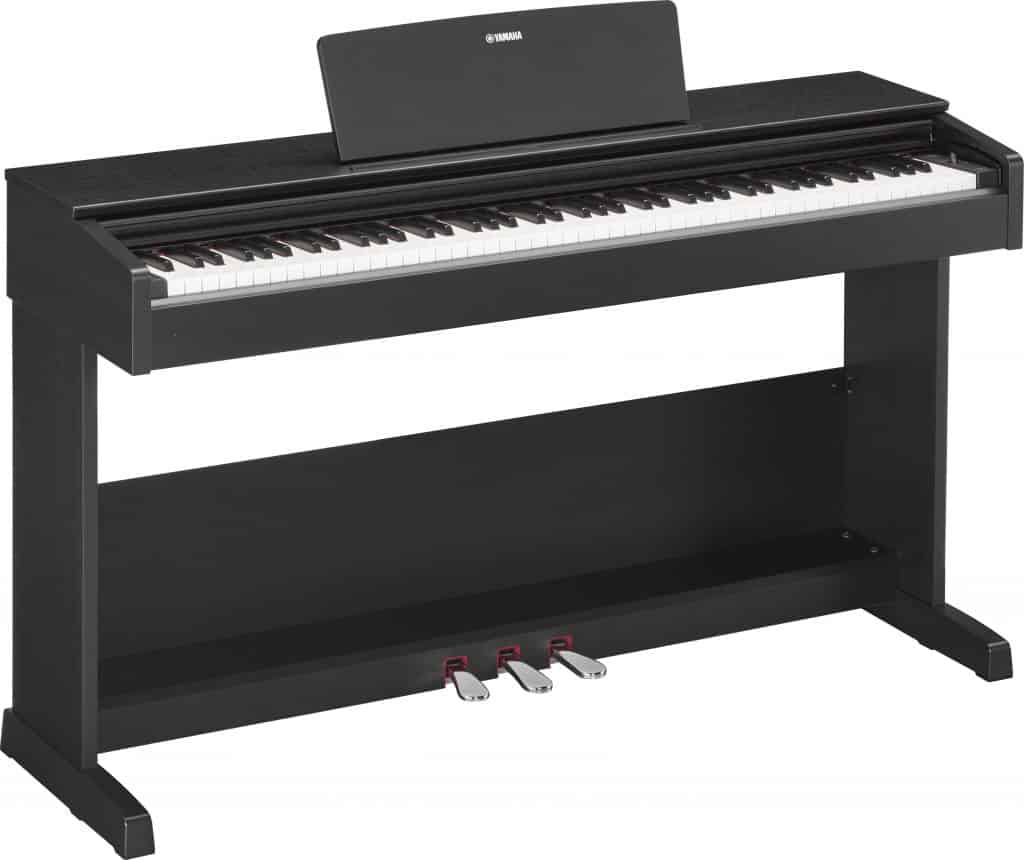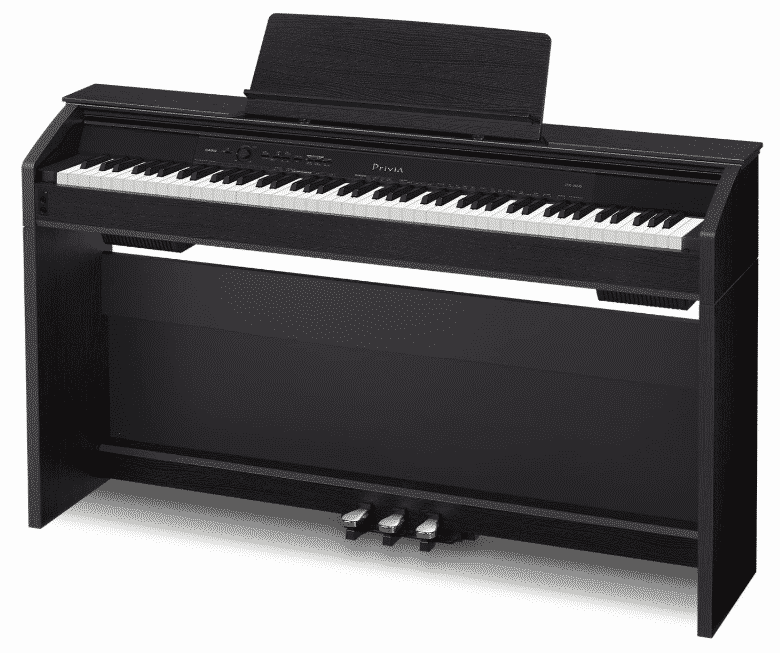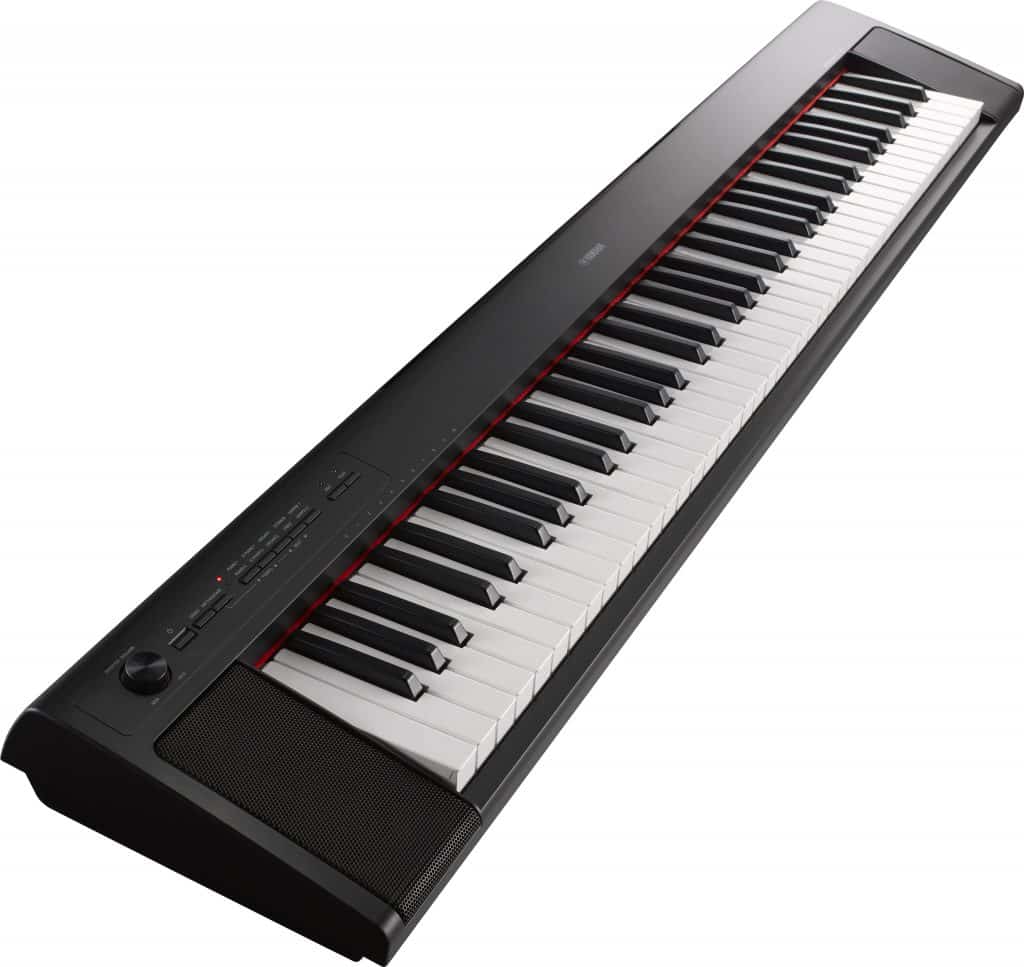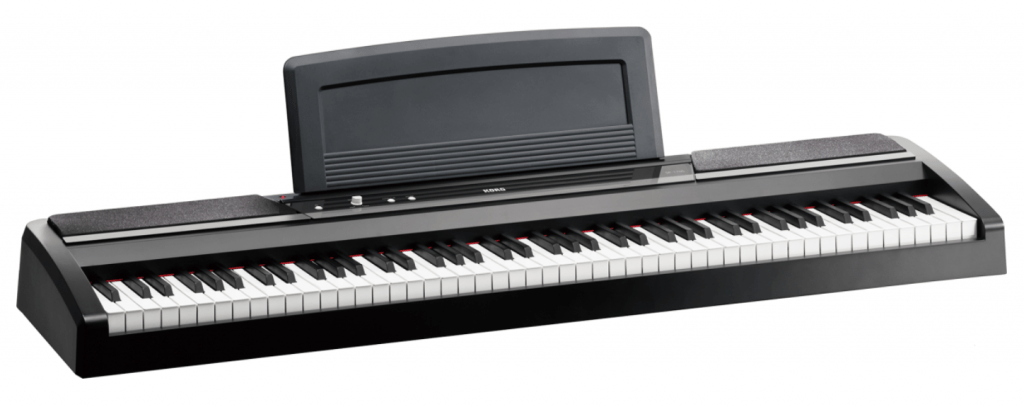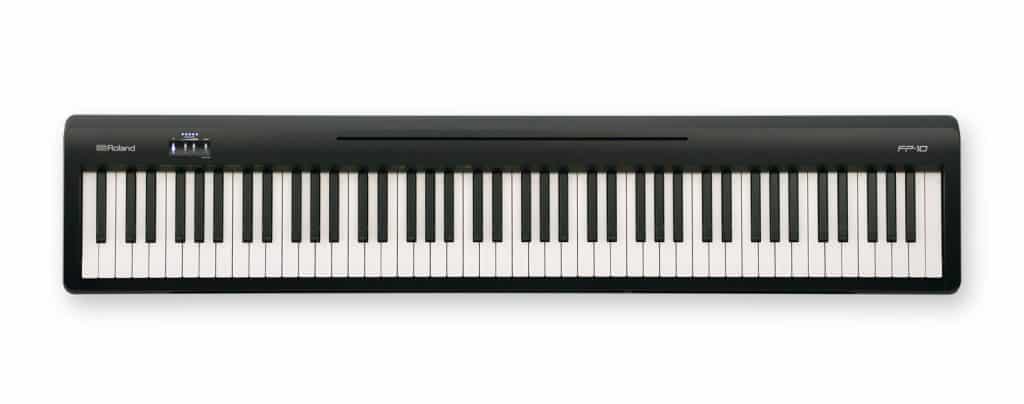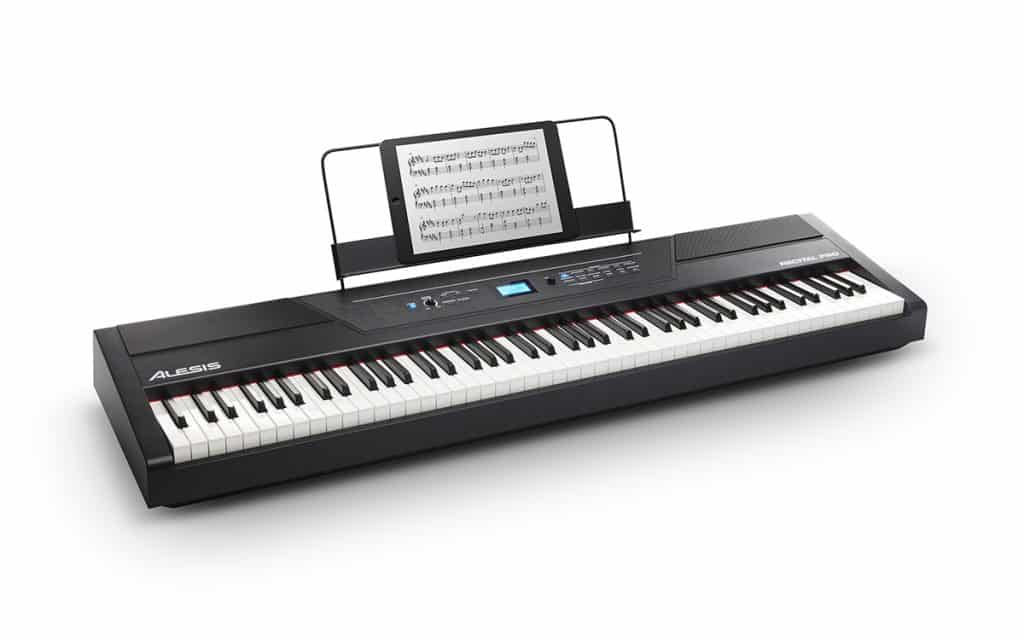A $1000 budget should be a big enough budget to buy a high-quality digital piano. In this guide, we’re exploring some of the best options at this price point, with features for beginners, intermediate and even some advanced pianists.
Not every product at this price range is created equal, and it is very easy to get a digital piano that doesn’t suit your needs.
The important thing is matching up the features you require with the features of a digital piano. Digital pianos can vary a lot in features. While some are purely designed to mimic the feel of an acoustic piano, some have features to help with arrangement, multiple voices and even learning modes.
There are many brands of digital piano and some have multiple ranges. It’s easy to get confused and struggle to identify the right model for your own needs.
Our research will make the decision easier. We’ve researched dozens of options to come up with a list of the best digital pianos under $1000. We’ve also discussed some of the vital needs and considerations when buying a digital piano.
If you are in hurry. Then our answer for the best digital piano under $1000 is Casio Privia PX-770. Check the price here!
What You Should Consider?
Size and Portability
One of the biggest considerations should be the size of the digital piano. Consider whether you need to take it out and about with you to shows or practice, or whether it will sit in the same part of your home.
Though some options are smaller, it is pretty standard for a digital piano to have 88 keys. This is the same as an acoustic model of piano. Some may be slightly smaller. 76 and 61 key models are likely to be sold as keyboards rather than digital pianos.
These 88 keys will be uniform in size, but the electronics and control panel that accompany the piano can vary. Bigger models may have LCD displays, big control panels and bulky speakers.
A portable option will be much more compact. Some digital pianos are designed to be lightweight and easily portable. These may come with stands that they can be placed upon to give a more “permanent fixture” feel to your piano when at home.
Weighted Keys and “Hammer Action”
Piano keys offer resistance when they are pressed. Also, the harder they are pressed, the louder the sound. Simply put, there is effectively a hammer hitting the piano wire that creates a tone, and the harder it hits, the more vibrations and therefore loudness.
Digital pianos tend to mimic the feel of weighted keys and the hammer action. They have an inbuilt touch sensitivity and similar resistance. This means that the harder the keys are pressed, the louder the sound. This is designed to feel and sound like an acoustic piano.
Naturally, the technology is different. However, the very best digital pianos feel almost exactly the same as an acoustic piano when they are played. Hammer actions and touch sensitivity mean more expression while playing. Most pianists will prioritize these features.
Voices and Sound Engine
The “voices” are the different tones and virtual instruments that can be played. Most digital pianos let you choose between multiple voices. They all tend to include a piano tone, but some also have violins, organs and other sounds.
The sound engine is what is driving this sound, how the voices have been created and how much expression they offer.
Some of the very best digital pianos are only equipped with 6-10 different voices. However, these sounds tend to be very good quality and are often sampled from acoustic pianos of the highest order.
The decision to make is whether you value quantity or quality. Some digital pianos have hundreds of tones, which can be good fun, and help with different styles of composing, but better individual voices might be preferable if you are looking for the most realistic piano feel.
Speakers
When you are performing, you will probably plug your digital piano into a PA system or amplifier, so the speakers don’t matter in this scenario. However, when practicing and playing at home, you’ll probably rely on the speakers.
The clarity and power of the speakers are both important. For instance, there’s very little point in getting really powerful speakers if they don’t give a clear, full-range piano sound.
Bigger models of digital piano tend to have more powerful speakers, which stands to reason. The smaller, more portable options may lack a bit of power.
Connectivity
We live in the age of the bedroom musician. Connectivity is important. How does the digital piano link to your other devices?
Some have companion apps for learning to play piano. Some digital pianos offer USB and MIDI connections for controlling other software (or even hardware). You can also sometimes use Bluetooth to play backing tracks through the speakers of your digital piano.
MIDI is a very popular format for connecting instruments. Some digital pianos with MIDI can connect to other hardware such as synthesizers, and allow you to play more complex melodies than some of the synths would otherwise allow, and with more expression.
MIDI connections to other virtual instruments can open up a world of possibilities. Most digital pianos have MIDI or at least a USB-MIDI interface, to allow you to use virtual instruments on a computer using MIDI technology.
If you just want your piano to stay in one place and work as a standalone instrument, this may not matter. However, if you want to use it as the central point of a home studio, think about how easily it can connect to other devices, hardware and software.
Portable or Console Digital Pianos
There are a couple of main designs of digital pianos. You are likely to buy a product that is marketed as a console digital piano or a portable digital piano. What is the difference?
Portable digital pianos are usually small and lightweight so they can be taken from one location to another. They may have a stand, but it is usually a folding or lightweight one, so it can be used at home or out of the home just as easily.
A console digital piano has the feel of an acoustic piano. They tend to sit up against a wall within the home, with a full, furniture-style stand that provides a great look to the piano.
They’re more of a permanent fixture. This is a great alternative to buying an acoustic piano. People who want the look and feel of an acoustic without the inconvenience often go for a console piano.
The way some of the stands work means that the actual piano can sometimes be removed from even a furniture stand so you can take it to shows with you.
Additional Features
There are many ways digital piano manufacturers try and outdo one another! They may add additional features that can help their digital piano stand out. Some features to look out for, which may or may not be useful, include:
- Recording options: Some digital pianos include multi-track recorders to let you record practices or compositions.
- Bundles: Digital pianos can come with a lot of accessories including stands, sustain pedals and headphones for private practice.
- Additional playing modes: such as “split” to load two sounds side-by-side on your piano, like a bass and keyboard sound. “Layer” may allow you to play two sounds simultaneously, and “lesson” modes make two identical keyboard ranges, splitting the keyboard into two, and making teaching piano a lot easier.
Benefits of a Digital Piano
Owning a piano can enhance most households. They can provide a talking point, but also introduce a bit of culture. Being able to play an instrument can be therapeutic and has even been linked to stimulating the brain and helping form new neural connections.
The benefits of a digital model include:
No Need for Tuning
Digital pianos do not fall out of tune over the months or even after years of use. Whereas an acoustic piano will need to be tuned, a digital piano always stays playable without the expense of calling in a tuner.
Loads of Different Sound Options
A lot of the time, digital pianos include multiple sound options including numerous models of acoustic piano sounds, organs, strings and even synth sounds. They can also be connected to virtual instruments to further enhance the sound options.
Portability and Size
You can’t easily take an acoustic piano from one place to another. The size and portability of a digital piano is usually a big plus point.
They may come with large stands and sit as a permanent fixture in your home, but it is likely that they will still be easier to remove and take on tour or to practice than a full-sized acoustic piano.
10 Best Digital Pianos Under $1000
Casio Privia PX-770 Digital Piano
The Casio Privia PX-770 combines value and quality, as an affordable price tag combines with AiR music technology to give a realistic feel and tone.
Features:
- 128 note maximum polyphony.
- USB connection.
- Tri-Sensor II Hammer Action.
- AiR sound engine.
- Headphone output.
- 88-keys.
The PX-770 is a good option for those looking for value along with a realistic feel. The graded hammer action means the lower keys have a harder feel and more resistance. Combined with the AiR sound engine make it an alternative to an acoustic piano with plenty of clarity and an enjoyable feel that mimics a grand piano.
- Graded hammer action means a realistic touch.
- Split, layer and duet modes allow more flexibility to playing.
- Can be used with or without the furniture style stand.
- Great value-for-money.
- The AiR piano tones are very realistic.
- 19 voices included in total.
- Other than the piano tones, the rest of the voices are not as high fidelity.
- Buttons and control panel have a bit of a flimsy look and feel.
Yamaha YDP103 Arius Series Digital Console Piano
This digital console piano comes in a furniture-style stand for an elegant feel. It’s great for those who want something to improve the look of their home as well as being enjoyable to play.
Features:
- 64 note maximum polyphony.
- USB and iOS connections.
- Full set of pedals.
- Pure CF sound engine.
- Headphone output.
- 88-keys.
The iOS connection makes this digital piano a good choice for those who want to use their iPhone or iPad to help with learning. Also, the full set of pedals including a sustain pedal add to the value of this piano, and gives the feel of being sat at an upright acoustic piano.
- Makes it easier to learn to use pedals.
- Easy to use with iOS devices.
- Pure CF sound engine modeled on Yamaha 9′ CFIIIS concert grand.
- Graded hammer action.
- Inbuilt two track recorder.
- Includes quality bench.
- 64 note polyphony is not as high as some other pianos.
- Not easily portable due to the size.
Roland GO-88P, 88-Key
Roland may be best known for synthesizers and other music equipment but not digital pianos. However, the Go-Keys range includes the GO-88P, an 88-key digital piano that has some impressive tech features to go with plenty of portability. It is also well under the $1000 mark.
Features:
- 128 note maximum polyphony.
- USB and Bluetooth connection.
- Only weighs 7KG.
- Can run on battery power.
- Headphone output.
- 88-keys.
- Speakers including Bluetooth connection for phone playback.
It’s clear that this digital piano is made with portability in mind. The 7KG weight is a big plus point for those who need to take their digital piano out and about with them. It’s ideal for putting in the car and taking to practice.
It can even run totally from battery power rather than needing to be plugged in. This means true “play anywhere” compatibility.
- Tech features including metronome and recording.
- Bluetooth connection. Play along to your favorite songs.
- Brilliant electric piano and organ sounds included.
- Lightweight and totally portable. Optionally wireless.
- Spring action but not fully weighted.
- Some of the piano tones are not as good as Yamaha and CF engines.
- Keys don’t feel as true to acoustic pianos as some other pianos.
Casio PX860 Privia Digital Home Piano
Another Casio Privia digital piano. This one comes with a bench and is an ideal home option rather than being overly portable. The speakers give 40W of power, and they are also high-quality. Great for playing at home and for friends at small gatherings.
Features:
- 256 note maximum polyphony.
- USB connection.
- Tri-Sensor II Hammer Action.
- AiR sound engine.
- Headphone output.
- 88-keys.
- Multiple modes including split and layer.
Once again, the brilliant Tri-Sensor action and AiR sound engine combine to give a realistic feel. Close your eyes while playing and you could easily think you were playing an upright acoustic.
Along with the included bench and pedals, these help to make the PX860 one of the most realistic feeling home pianos out there available for under $1000.
Pros
- Very enjoyable and realistic key action.
- 19 voices, more than many other Casio keyboards.
- Easy to assemble even though it comes with a bench.
- Really powerful speakers. This is one of the loudest digital piano choices.
Cons
- Sustain pedal is not as high-quality as the other features.
- Some of the control panel configurations can be confusing.
Yamaha P45, 88-Key
This is the first portable Yamaha digital piano we’ve included on our list of the best digital pianos under $1000. In spite of being a bit smaller and more lightweight than their console models, it still has a realistic feel to the touch. Also, this digital piano can be bought as a bigger bundle with a lot of accessories.
Features:
- 64 note maximum polyphony.
- USB connectivity.
- Dual mode to play two sounds.
- GHS weighted action.
- Headphone output.
- 88-keys.
- Advanced Wave Memory Stereo Sampling.
Some portable keyboards lose some of the realistic feel and sound that most people look for in a digital piano. The P45 does a great job of keeping this while still being lightweight and easy to transport.
The Advanced Wave Memory Stereo Sampling system means that the sounds played have been sampled in high quality. They are triggered by the GHS keys to give a responsive hammer action feel.
Pros
- Natural stereo sound to the piano voices.
- Weighted and graded pianos for a realistic piano feel.
- Very simple operation and control panels. Easy to change the sounds.
- Includes a metronome and a layering mode.
- Can be bought bundled with pedals, stand and more.
Cons
- More expensive than some other portable digital pianos.
- Volume of the speakers isn’t very high.
- Can’t be used with three pedals, just compatible with one.
Yamaha NP32 Portable Digital Piano
This model definitely stands out when compared to the other digital pianos, as it is very different. This has put portability very high on the list of priorities and it is only a 76-key digital piano.
Some people are just looking for the most easily portable model and the NP32 might be a good option. It’s fair to call this a minimalist digital piano, but that could fit your needs perfectly.
Features:
- 64 note maximum polyphony.
- USB and iOS connectivity.
- Graded Soft Touch keyboard.
- Headphone output.
- 76-keys.
- Advanced Wave Memory Stereo Sampling.
In spite of the fact that this is a simple and lightweight keyboard, it has easy connectivity for USB and iOS devices. The iOS app has a control interface so people can get more out of their digital piano.
Though it doesn’t have the same hammer action as other digital pianos, it does have a weighted action. The “Graded Soft Touch” has a relatively realistic feel. The 76-key design isn’t for everyone, but it is easy to take from place to place.
Pros
- Lightweight and portable.
- Controller app for iOS devices.
- Has a recording function.
- Advanced Wave Memory Stereo Sampling is the same as more expensive pianos.
Cons
- 76 keys and 64 note polyphony can be limiting for some advanced players.
- Speaker system is a little quiet, but fine for practice.
Korg 88-Key SP-170
Korg is a manufacturer that is very well known for making a range of musical equipment, including synthesizers.
This is a good digital piano that is very flexible and can be used at home with a stand or taken out and about. You can take this to gigs or just set it up in your music room at home.
Features:
- 120 note maximum polyphony.
- USB connectivity.
- Natural Weighted Hammer Action
- Headphone output.
- 88-keys.
- Includes effects such as reverb and chorus.
Korg are known for their quality when it comes to guitar effects, music tech and synths. This is possibly why the SP-170 includes effects. This can be a big bonus for some people, depending on what you are looking for.
It can add more in the way of dynamics and interest in terms of the sound created. There are only 10 sounds included, but they are all of a high standard.
Pros
- Natural feel with weighted keys and a hammer action.
- Good value, comes in well below $1000.
- Includes effects so that you can alter the sound to your preferences.
- The Korg Grand Piano voice is particularly good.
Cons
- Included sustain pedal is not very high quality.
- No stereo voicing modes to provide huge levels of detail.
- Could do with a few more sounds, there are only 10 in total.
Roland FP-10 Digital Piano Bundle
The Roland FP-10 is another model that can be used portable, taken to gigs, or can be placed on a furniture style stand in order to become a stationary home model.
Roland create some great products and their digital pianos feature a lot of high-technology and modern extras. For instance, this piano has the ability to link to a companion app.
Features:
- 96 note maximum polyphony.
- Graded Soft Touch keyboard
- USB and iOS connectivity with companion app.
- SuperNATURAL Piano sound engine for quality stereo sounds.
- PHA-4 Standard keyboard provides authentic piano touch.
- Built-in Bluetooth and MIDI interface.
The PHA-4 Standard keyboard is a great system for weighted keys. These feel really natural, and though Roland are known as an “all round” music tech manufacturer, the FP range has really put them on the map when it comes to piano. The SuperNATURAL sound engine gives excellent, stereo piano sounds. The inbuilt interface makes it easy to play along to songs streamed from your Bluetooth device. You can also plug this into other software and hardware.
Pros
- Excellent compatibility with other devices due to the MIDI and Bluetooth interface.
- Quite a compact cabinet so it doesn’t take up too much space.
- Piano Partner 2 companion app for added control.
- Excellent stereo sound with powerful speakers to amplify.
Cons
- Pedals are not as high-quality as you would expect.
- To get the most out of this you need to connect to a tablet or computer.
Yamaha P125 88-Key Weighted Action Digital Piano
Yamaha and Casio definitely dominate our list. The P125 is a very popular model from Yamaha and it provides a very authentic feel and sound although it is still pretty small and lightweight enough to be a portable choice.
Like a lot of the other options on our list, it can be used as a console piano with a stand or taken out and about just as simply. Though not ultra-lightweight, it’s not too difficult to put in the back of a car and take to shows.
Features:
- 192 note maximum polyphony.
- USB connectivity.
- Pure CF Stereo Sampling and sound engine.
- GHS weighted action.
- Headphone output.
- 88-keys.
The P125 is a real “all rounder”. The Pure CF stereo sampling combines with two fairly powerful speakers to make the inbuilt sound more than good enough for most of us.
The tech features and compatibility are also pretty good, as it can be used with smart devices such as iPhones and tablets. Multiple voices, rhythms and settings can all be controlled with the “Smart Pianist” app which is totally free.
Pros
- Versatile digital piano. Light enough to take to shows with a portable stand.
- Very high 192 note polyphony for complex playing.
- Buy in different bundles to play at home or on the go.
- Simple USB to host allows use with a computer.
Cons
- Sustain pedal is not really up to standard.
- 38 pounds in weight so it’s a bit heavier than some other portable digital pianos.
- Speakers are good, but not amazing for the price.
Alesis Recital Pro
This is not just under $1000, the Alesis Recital Pro is well under $1000, and provides a good option for beginners, with some learning fixtures included.
One of the reasons it is worth including on a list of the top 10 best digital pianos is that it actually far outperforms a lot of the other options that are similar in price, or even some slightly more expensive digital pianos.
The recital pro also gives a graded hammer action (the Alesis Recital standard model only offers semi-weighted keys).
Features:
- 128 note maximum polyphony.
- USB connectivity.
- 88 premium full sized hammer action keys.
- Headphone output.
- 20W built-in speakers
- Built In effects. Chorus, Reverb, Modulation
For such an affordable digital piano, this has a fairly realistic feel and a weighted, hammer-action design on all the keys. The most impressive features besides the incredible value for money are the inbuilt effects and the speakers.
There aren’t many digital pianos offering effects such as reverb, and these combine with 12 high-quality sounds to give loads of options for playing. 20W speakers are also very powerful for a compact digital piano.
With that price, noth versions Alesis Recital and Alesis Recital Pro are one of the best digital pianos under $500 as well.
Pros
- Excellent value-for-money.
- Lots of options for altering the sound due to the onboard effects.
- Lesson & Record Modes help with learning to play the piano.
Cons
- Key “action” is quite loud. The keys don’t feel the nicest to play.
- Sound engine is not as good as the Casio or Yamaha options.
Frequently Asked Questions
There are some questions that tend to crop up repeatedly when people are looking for digital pianos under $1000.
How Can I Get a Digital Piano Closest to an Acoustic Piano?
A lot of people are transitioning from acoustic piano to digital piano. How can people make sure they end up with a piano they are happy with, that has the same feel as an acoustic piano?
The main features to look out for are hammer actions and realistic sound engines. A lot of the best digital pianos have sound engines that accurately sample acoustic models by the same brand. Yamaha, for instance, have a Pure CF engine that provides piano sounds based on acoustic models in their range.
Do Digital Pianos Need to be Serviced?
An acoustic piano needs servicing from time-to-time, mainly meaning that they need to be tuned. This is not the case with a digital piano. Though you will want to keep your piano clean and in good working order, you won’t need to tune it.
Is $1000 a Sufficient Budget for a Digital Piano?
Working out how much money to spend on a digital piano can be a difficult decision. Though we’ve featured products at a lot of different price ranges, $1000 is plenty to buy a best digital piano for beginners and intermediate players, and some of the models on our list are perfectly acceptable for use on stage for performances.
Summary
A digital piano has a lot of benefits. It won’t need to be tuned, and most models are easy to take from place to place. Digital pianos can also be easily plugged into effects and amplified via PA systems or amplifiers. Some also have additional features such as learning modes that simply wouldn’t be an option with an acoustic piano.
To make the right choice for your own needs, think about whether you need a realistic feel, with hammer action and realistic sounds. Alternatively, you might want the maximum number of sounds, or you may prioritize portability over other features.
The Casio Privia PX-770 Digital Piano is our number one option. It has a fantastically detailed sound engine, plenty of power from the speaker system and a brilliant graded hammer action. Whether you are learning afresh or transitioning from an acoustic model, the Privia can give a fantastic, versatile and relatively affordable option.

